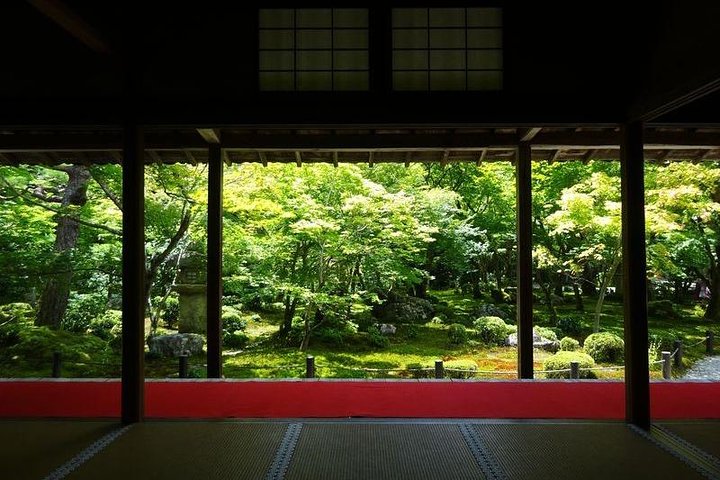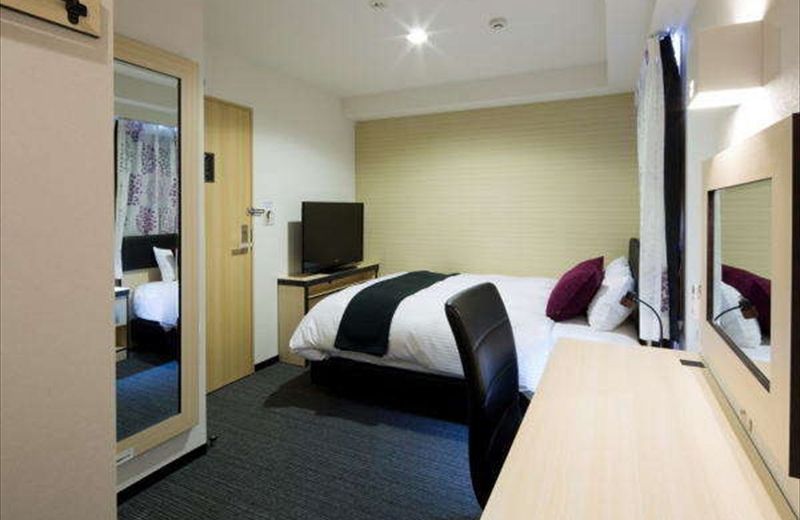Why choose this Kyoto tour ?
Traditional and historical Japanese gardens are best sites to see Japanese aesthetics. Both artistic landscape gardens with seasonal plants and dry landscape gardens at Zen temples help you get relaxed for meditation. Visiting various styled gardens and experiencing traditional Japanese spirits which are represented in plants, rocks, and total design.
Our government-licensed and experienced multilingual guides will help you efficiently enjoy a one-day private tour of the best Japanese gardens in Kyoto.
Select gardens from a list in the tour information to create your customized itinerary. In addition to gardens, you may also choose any famous site in Kyoto for a truly memorable experience!
Note*1: Please select your must-see spots from a list in the tour information to create your customized itinerary.
Note*2: National Government Licensed Guide Interpreter certification is issued by the Japanese government requires a good knowledge and understanding of Japanese culture and history.
Make the most of your Kyoto adventure
What makes Kyoto Japanese Garden Lover’s Private Tour with Government-Licensed Guide a unique experience ?
Kinkakuji (金閣寺, Golden Pavilion) is a Zen temple in northern Kyoto whose top two floors are completely covered in gold leaf. Formally known as Rokuonji, the temple was the retirement villa of the shogun Ashikaga Yoshimitsu, and according to his will it became a Zen temple of the Rinzai sect after his death in 1408. Kinkakuji was the inspiration for the similarly named Ginkakuji (Silver Pavilion), built by Yoshimitsu’s grandson, Ashikaga Yoshimasa, on the other side of the city a few decades later.
Kinkakuji is an impressive structure built overlooking a large pond, and is the only building left of Yoshimitsu’s former retirement complex. It has burned down numerous times throughout its history including twice during the Onin War, a civil war that destroyed much of Kyoto; and once again more recently in 1950 when it was set on fire by a fanatic monk. The present structure was rebuilt in 1955.
Ginkakuji (銀閣寺, Silver Pavilion) is a Zen temple along Kyoto’s eastern mountains (Higashiyama). In 1482, shogun Ashikaga Yoshimasa built his retirement villa on the grounds of today’s temple, modeling it after Kinkakuji (Golden Pavilion), his grandfather’s retirement villa at the base of Kyoto’s northern mountains (Kitayama). The villa was converted into a Zen temple after Yoshimasa’s death in 1490.
As the retirement villa of an art obsessed shogun, Ginkakuji became a center of contemporary culture, known as the Higashiyama Culture in contrast to the Kitayama Culture of his grandfather’s times. Unlike the Kitayama Culture, which remained limited to the aristocratic circles of Kyoto, the Higashiyama Culture had a broad impact on the entire country. The arts developed and refined during the time include the tea ceremony, flower arrangement, noh theater, poetry, garden design and architecture.
Starting with an incredibly scenic approach that culminates in a moss-covered gate, Honen-in works its magic on the visitor right from the start. Once inside, you’ll pass between two sand mounds that are said to purify the visitor. You then cross a lovely stone bridge over a pond and then make you way through a moss-covered garden to find yourself at a secret grotto behind the main hall.
Nanzenji Temple (南禅寺), whose spacious grounds are located at the base of Kyoto’s forested Higashiyama mountains, is one of the most important Zen temples in all of Japan. It is the head temple of one of the schools within the Rinzai sect of Japanese Zen Buddhism and includes multiple subtemples, that make the already large complex of temple buildings even larger.
The history of Nanzenji dates back to the mid 13th century, when the Emperor Kameyama built his retirement villa at the temple’s present location and later converted it into a Zen temple. After its founding, Nanzenji grew steadily, but its buildings were all destroyed during the civil wars of the late Muromachi Period (1333-1573). The oldest of the current buildings was built after that period.
Tofukuji (東福寺, Tōfukuji) is a large Zen temple in southeastern Kyoto that is particularly famous for its spectacular autumn colors. The temple was founded in 1236 at the behest of the powerful Fujiwara clan. Its name is a combination of the names of two great temples in Nara that were also associated with the Fujiwara, Todaiji Temple and Kofukuji Temple. Tofukuji has historically been one of the principal Zen temples in Kyoto, and is a head temple of one of the schools of the Rinzai sect of Zen Buddhism.
In autumn, people come from all over Japan to see Tofukuji’s autumn colors. The most popular view is of the Tsutenkyo Bridge, which spans a valley of lush maple trees. The view from the bridge is equally spectacular, and the 100 meter long, covered walkway becomes extremely crowded when the colors reach their peak, usually around mid to late November.
The Kyoto Imperial Palace (京都御所, Kyōto Gosho) used to be the residence of Japan’s Imperial Family until 1868, when the emperor and capital were moved from Kyoto to Tokyo. It is located in the spacious Kyoto Imperial Park (京都御苑, Kyōto Gyoen), an attractive park in the center of the city that also encompasses the Sento Imperial Palace and a few other attractions.
Shugakuin Imperial Villa (修学院離宮, Shugakuin Rikyū) was built in the 17th century by Emperor Gomizuno and is now managed by the Imperial Household Agency. It consists of the Upper, Middle and Lower Villa areas, each featuring gardens and buildings of the traditional imperial style.
Shugakuin’s name comes from a former temple built on the same site in the tenth century. The Imperial Villa was constructed between 1655 and 1659, with a palace for Gomizuno’s daughter added ten years later. More recently in 1964, the surrounding farmlands were bought by the Imperial Household Agency. They are leased out to local farmers who continue to work the fields.
Ryoanji Temple (龍安寺, Ryōanji) is the site of Japan’s most famous rock garden, which attracts hundreds of visitors every day. Originally an aristocrat’s villa during the Heian Period, the site was converted into a Zen temple in 1450 and belongs to the Myoshinji school of the Rinzai sect of Zen Buddhism, whose head temple stands just a kilometer to the south.
As for the history of Ryoanji’s famous rock garden, the facts are less certain. The garden’s date of construction is unknown and there are a number of speculations regarding its designer. The garden consists of a rectangular plot of pebbles surrounded by low earthen walls, with 15 rocks laid out in small groups on patches of moss. An interesting feature of the garden’s design is that from any vantage point at least one of the rocks is always hidden from the viewer.
The garden at Taizo-in, one of the subtemples of Myoshin-ji Temple, in northwest Kyoto, is among Kyoto’s most famous. It’s highly recommended in any season.
Visiting the Zen temple complex of Daitoku-ji in northern Kyoto, you will discover temples within temples. Michael Lambe guides us through its rich history and the deep significance of its many meditative gardens.
Katsura Imperial Villa (桂離宮, Katsura Rikyū) is one of the finest examples of Japanese architecture and garden design. The villa and garden in their present form were completed in 1645 as the residence for the Katsura Family, members of Japan’s Imperial Family.
Visiting Katsura Imperial Villa requires joining a tour. The tour follows the garden’s circular walking trail around the central pond. Palace buildings can be viewed only from the outside, and photographing is allowed only from designated spots. Tours in English are available.
The Togetsukyo Bridge (lit. “Moon Crossing Bridge”) is Arashiyama’s most iconic landmark. It was originally built during the Heian Period (794-1185) and most recently reconstructed in the 1930s. The bridge looks particularly attractive in combination with the forested mountainside in the background. A riverside park with dozens of cherry trees is located just adjacent to the bridge.
The walking paths that cut through the bamboo groves make for a nice walk or bicycle ride. The groves are particularly attractive when there is a light wind and the tall bamboo stalks sway gently back and forth. The bamboo has been used to manufacture various products, such as baskets, cups, boxes and mats at local workshops for centuries.
This is the former villa of the popular actor Okochi Denjiro (1896-1962), located in the back of Arashiyama’s bamboo groves. Okochi Sanso consists of several different gardens and buildings, including living quarters, tea houses and gates. The buildings can only be viewed from the outside.
Gioji is even more nestled into the forest than Jojakkoji and Nisonin. It is known for its moss garden that is punctuated with tall maple trees. The temple’s entrance gate and small main hall have thatched roofs. The latter has an attractive round window looking into the gardens.
Tour Description & Additional Info:
- Service animals allowed
- Public transportation options are available nearby
- Infants and small children can ride in a pram or stroller
- All areas and surfaces are wheelchair accessible
- Transportation options are wheelchair accessible
- Wheelchair accessible
- Suitable for all physical fitness levels
- This is a walking tour. Pick up is on foot.
Options To Choose for Your Trip:
- Kyoto Japanese Garden Lover’s Private Tour with Government-Licensed Guide
Add
Pickup included
Kyoto Japanese Garden Lover’s Private Tour with Government-Licensed Guide Inclusions:
Included with Your Ticket
- Customizable Walking Tour of your choice of 3-4 sites from ‘What to expect’ list
- Meet up with guide on foot within designated area of Kyoto
- Licensed Local English Speaking Guide
Not Included
- Transportation fees, Entrance fees, Lunch, and Other personal expenses
- Private Vehicle
- You cannot combine multiple tour groups.
- Guide Entry fees are only covered for sights listed under What to Expect.
Trending Kyoto Nearby Tours Likely To Sell Out
Special Instructions:
- This Tour is Provided by Japan Guide Agency.
- Tour Timezone & Starts at Asia/Tokyo.
- Mobile or paper ticket accepted.
- For a full refund, cancel at least 24 hours before the scheduled departure time.
- This Tour is Rated 5 Stars based on 7 valid reviews on VIATOR.
- Minimum 1 Travelers is required to book.
- Maximum 10 Travelers is accepted for booking.









